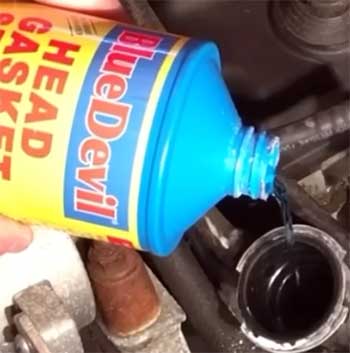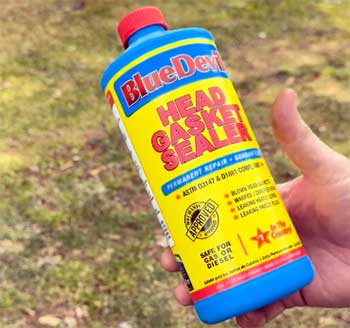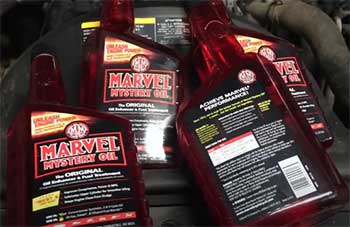I’m no mechanic, but when my car started acting up—white smoke, coolant disappearing faster than my paycheck—I knew I was in trouble. A blown head gasket was the culprit, and the repair bill? Let’s just say it was more than my rent.
That’s when I stumbled across BlueDevil Head Gasket Sealer. This stuff promised a quick fix without tearing my engine apart, and I was desperate enough to try it. Spoiler alert: it worked better than I expected.
If you’re facing a similar headache, grab BlueDevil—it’s a lifesaver you’ll want in your garage.
My Experience With BlueDevil Head Gasket Sealer

Picture this: it’s a chilly morning, and my 2003 Honda Civic is puffing out white smoke like it’s auditioning for a fog machine.
The temperature gauge is climbing, and I’m topping off the coolant every other day.
A mechanic friend confirmed the worst—a blown head gasket.
The fix?
A cool $2,000 I didn’t have.
So, I started scouring forums and stumbled across BlueDevil Head Gasket Sealer.
At around $60 for a 32-ounce bottle, it felt like a gamble, but a cheap one compared to a full repair.
I went for the original BlueDevil, not the Pour-N-Go version, because I read it’s better for serious leaks.
The process wasn’t exactly “pour and go,” though. I had to drain the coolant, remove the thermostat (which was a pain with my rusty bolts), and flush the system with BlueDevil’s radiator flush.
Then, I poured in the sealer, filled the system with water, and let the engine idle for 50 minutes while cranking the heater to max. The instructions were clear, but I double-checked YouTube to make sure I wasn’t about to ruin my engine.
After the idle, I topped off the coolant and crossed my fingers. The first drive was nerve-wracking—every puff of exhaust had me paranoid. But after a few days, the white smoke was gone, the coolant level stabilized, and the engine ran smoother.
It’s been six months, and my Civic’s still kicking without a hiccup. I’m not saying it’s a permanent fix, but it bought me time to save for a proper repair. I’ve since used it on a friend’s old Toyota, and it worked like a charm there too.
BlueDevil’s not magic, but it’s as close as you’ll get for $60.
Pros of BlueDevil Head Gasket Sealer
- Easy Application for Non-Mechanics

You don’t need to be a gearhead to use BlueDevil.
The instructions are straightforward—drain, flush, pour, idle, and refill.
I managed it with basic tools and a YouTube tutorial.
The Pour-N-Go version is even simpler, though I stuck with the original for my 6-cylinder engine.
No special skills or fancy equipment required, just patience and a willingness to get your hands dirty.
For someone like me, who’s more comfortable with a laptop than a wrench, this was a huge relief.
- Cost-Effective Alternative to Repairs
Let’s talk numbers. A head gasket replacement can cost anywhere from $1,500 to $2,500, depending on your car. BlueDevil? About $60 for the 32-ounce bottle, less for the 16-ounce. That’s a fraction of the price.
For older cars or beaters, like my Civic with 140,000 miles, it’s a no-brainer. Even if it’s not a forever fix, it’s a budget-friendly way to keep your car running while you figure out your next move. I saved enough to cover my rent and still had change for coffee.
- Versatile for Multiple Engine Types
BlueDevil works with both gasoline and diesel engines, which is a big win. Whether you’re driving a 4-cylinder Honda or a beefy 8-cylinder truck, it’s got you covered. It also bonds to various materials—metal, aluminum, plastic, you name it.
I used it on my Civic and later helped a buddy with his diesel pickup. Both times, it sealed the leaks without issue. This versatility means you’re not stuck buying a specific product for your engine type, which is a hassle with some other brands.
- No Harmful Particulates
One of my biggest worries was clogging my cooling system. I’d heard horror stories about other sealers gunking up radiators. BlueDevil’s formula is free of solids or particulates, so it won’t clog your heater core or radiator.
I checked my radiator after a month, and it was clean—no “Crisco grease” nightmares like some users reported with improper use. Knowing it’s safe for my engine gave me peace of mind, especially since I’m no expert on cooling systems.
- Quick Action Time
Time is money, and BlueDevil gets to work fast. The 50-minute idle process is all it takes to seal most leaks. After that, I noticed results within days—no more white smoke or coolant loss. Compared to a mechanic visit that could take days (and a chunk of your savings), this is a game-changer.
For minor leaks or cracks, it’s like hitting the fast-forward button on your repair. I was back on the road without missing a beat.
Also Read: Is BlueDevil Rear Main Sealer Worth It?
Not-So-Good Parts of BlueDevil Head Gasket Sealer
- Not a Permanent Fix for Major Damage

Let’s be real—BlueDevil isn’t a miracle worker.
If your head gasket is completely shot or your engine block is cracked, this stuff won’t save you.
It’s designed for minor to moderate leaks, like pinhole leaks or small cracks in the head or block.
My Civic had a minor leak, and it worked great, but forums are full of stories where severe damage overwhelmed the sealer.
If your car’s blowing coolant into the combustion chamber or overheating constantly, you’re better off biting the bullet and getting a proper repair.
- Tricky Application for Some Vehicles
The application process isn’t rocket science, but it’s not always a breeze. Removing the thermostat was a hassle on my Civic—rusty bolts and tight spaces made it a 30-minute ordeal.
If your car doesn’t have a radiator cap (some modern ones only have a reservoir), you’ll need to pour the sealer through the radiator hose, which is a pain. I also heard from a Reddit user who accidentally clogged their system by not flushing properly.
Follow the instructions to a T, or you’re asking for trouble.
- Mixed Long-Term Results
While BlueDevil worked for me, not everyone’s singing its praises. Some users on Reddit and Amazon reported it lasting only a few months before leaks returned. Others, like a guy with a 4Runner who clocked 40,000 miles post-sealer, swear it’s a long-term fix.
The truth?
It depends on your car, the leak’s severity, and how well you apply it. I’m six months in and counting, but I’m not betting on it lasting forever. It’s a stopgap, not a substitute for a new head gasket.
- Opaque Bottle Design
This one’s minor but annoying. The BlueDevil bottle is opaque, so you can’t see how much sealer is left. When I was pouring it into my radiator, I had to guess if I was using the right amount.
For a 6-cylinder engine, you need the whole 32-ounce bottle, but it would’ve been nice to see the level to avoid over- or under-pouring. It’s a small design flaw that could make the process smoother, especially for nervous first-timers like me.
Tips To Maximize BlueDevil’s Effectiveness
- Flush Your Cooling System Thoroughly
Before you even think about pouring in BlueDevil, flush your cooling system like your life depends on it. I used BlueDevil’s radiator flush and ran water through the system three times to get rid of old coolant and debris.
A clean system ensures the sealer can circulate properly and bond to the leaks. Skip this step, and you’re risking clogs or reduced effectiveness. Trust me, the extra 20 minutes of flushing is worth it to avoid a $500 repair bill later.
- Monitor Coolant Levels Post-Application
After using BlueDevil, keep an eye on your coolant levels for the first few weeks. I checked mine daily for the first week, then weekly for a month. If the level drops, you might have a bigger issue than BlueDevil can handle.
In my case, the levels stayed steady, which was a good sign the sealer did its job. Regular checks give you peace of mind and catch any problems early before they turn into a roadside disaster.
- Drive Regularly to Circulate the Sealer
BlueDevil needs to circulate through your system to work its magic. After applying it, I made a point to drive my Civic daily for short trips—15 to 20 minutes—to let the sealer settle into the cracks.
Don’t let your car sit in the driveway for weeks; regular driving keeps the sealer active and helps it bond properly. It’s like shaking a can of spray paint—you’ve got to keep things moving.
- Avoid Overheating After Application
Overheating is the enemy of any head gasket repair, sealed or not. I kept a close eye on my temperature gauge for the first month, especially during that 50-minute idle period.
If your engine starts running hot, turn it off and let it cool before restarting. BlueDevil can’t fix an engine that’s constantly overheating, so fix any cooling system issues—like a bad radiator or thermostat—before using the sealer.
- Regular Engine Maintenance
Using BlueDevil doesn’t mean you can skip regular maintenance. Keep up with oil changes, coolant flushes, and radiator checks to extend your engine’s life.
I started changing my oil every 5,000 miles and flushing the coolant every two years to prevent further issues. BlueDevil’s a great fix, but it’s not a free pass to neglect your car. Treat your engine right, and it’ll return the favor.
Comparison With Other Head Gasket Sealer Brands
Let’s talk competition. BlueDevil isn’t the only player in the head gasket sealer game, so how does it stack up against brands like K-Seal, Steel Seal, and Bar’s Leaks? I’ve done some digging, tried a couple myself, and talked to other car owners to get the full picture.
K-Seal is the “shake, pour, and go” option, priced around $20 for a 16-ounce bottle. It’s super easy to use—no thermostat removal or system flush required. I tried it on a friend’s Subaru with a small leak, and it worked within a day.
The catch?
It’s best for minor leaks and might not hold up for bigger issues like my Civic’s. Some users reported coolant discoloration, so you might need to flush the system afterward. BlueDevil feels more robust for moderate leaks, but K-Seal wins for simplicity and price.
Steel Seal, at $60-$80 for two bottles, is marketed for larger engines, like 8-cylinders. A mechanic friend swore by it for a van with warped heads, saying it lasted years. But the process is intense—multiple steps, precise timing, and some automotive know-how.
I passed on it because it felt too complicated compared to BlueDevil’s straightforward process. If you’ve got a big engine and patience, Steel Seal might edge out BlueDevil, but for most folks, BlueDevil’s easier.
Bar’s Leaks Head Gasket Fix is another budget option, around $25 for 20 ounces. I haven’t used it, but a Reddit thread claimed it stopped a leak in a Ford V6 for over a year. The downside?
It uses pellets that can clog smaller passages if not applied correctly. BlueDevil’s particulate-free formula feels safer, especially for older cars like mine. Bar’s Leaks is a solid pick for quick fixes, but I’d trust BlueDevil more for long-term reliability.
Overall, BlueDevil strikes a balance—affordable, effective for moderate leaks, and safe for most engines. K-Seal’s cheaper and simpler, Steel Seal’s better for heavy-duty engines, and Bar’s Leaks is a gamble with clogs. For my Civic, BlueDevil was the sweet spot, and I’d pick it again over the others.
Frequently Asked Questions (FAQ)
BlueDevil works great for minor to moderate head gasket leaks, warped heads, or cracked heater cores. In my experience, it stopped my Civic’s coolant loss and white smoke within days. User reviews on Reddit and Amazon back this up, with many reporting success on 4- and 6-cylinder engines. However, it’s not foolproof for severe damage—think major cracks or combustion gas leaks. A shop quoted me a 60% success rate for buying 6-12 months, and my six months so far align with that. Follow the instructions exactly, and you’ve got a solid shot at a temporary fix.
It varies. For me, BlueDevil’s held strong for six months with no leaks. A Reddit user with a 4Runner reported 40,000 miles and counting, while others saw leaks return after a few months. The sealer’s longevity depends on your engine’s condition, leak severity, and how well you apply it. Minor leaks might stay sealed for years; bigger ones might need reapplication or a proper repair sooner. Regular maintenance, like coolant checks, helps stretch its lifespan. Don’t expect a permanent fix, but it can buy you serious time.
BlueDevil tackles blown head gaskets, warped or cracked heads, leaking heater cores, and freeze plugs. It sealed my Civic’s pinhole head gasket leak, stopping coolant loss and white smoke. It’s also fixed similar issues in diesel trucks and older Toyotas, according to forums. It bonds to metal, aluminum, and plastic, making it versatile. But if your engine’s got major cracks or combustion gases mixing with coolant, it might not cut it. For small to medium leaks, it’s a reliable patch.
Yes, you can drive after applying BlueDevil, but wait until the 50-minute idle process is done and the system’s refilled with coolant. I drove my Civic the next day for short trips, and it held up fine. BlueDevil recommends driving regularly to circulate the sealer, but avoid long hauls right away—stick to local drives for a week to let it settle. If your engine’s overheating or the leak’s severe, don’t push it. Monitor the temperature gauge and coolant levels to avoid bigger problems.
Conclusion: BlueDevil Is A Must-Have For Car Owners
I’ll be honest—BlueDevil Head Gasket Sealer saved my wallet and my sanity. It’s not a permanent fix, but for $60, it’s a game-changer for minor to moderate leaks. Whether you’re nursing an old beater or buying time for a proper repair, this stuff delivers.
From its easy application to its engine-safe formula, it’s a no-brainer for anyone facing a head gasket issue. Grab a bottle, follow the instructions, and keep your car running without breaking the bank.
BlueDevil’s got your back—trust me, I’m living proof.

